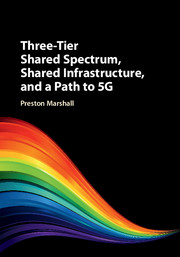Book contents
- Frontmatter
- Contents
- Acknowledgments
- Preface
- Part I Spectrum Sharing Background
- Part II Three-Tier Dynamic Spectrum Models
- Part III Components of a Three-Tier Architecture
- Part IV Protection Processes for Incumbents and Peers
- 8 General Process for Database System Operation
- 9 Protection of Incumbent Satellite Operations
- 10 Protection to and From Terrestrial Access Points and Point-to-Point Networks
- 11 Protection to and From Radar Systems
- 12 Coexistence Between Unprotected Peer Devices
- Part V Example Use of Three-Tier Spectrum: Use of the 3.5 GHz CBRS Band in the USA
- Part VI Future Bands, Network Services, Business Models, and Technology
- Part VII Appendices
- Index
- References
9 - Protection of Incumbent Satellite Operations
from Part IV - Protection Processes for Incumbents and Peers
Published online by Cambridge University Press: 30 August 2017
- Frontmatter
- Contents
- Acknowledgments
- Preface
- Part I Spectrum Sharing Background
- Part II Three-Tier Dynamic Spectrum Models
- Part III Components of a Three-Tier Architecture
- Part IV Protection Processes for Incumbents and Peers
- 8 General Process for Database System Operation
- 9 Protection of Incumbent Satellite Operations
- 10 Protection to and From Terrestrial Access Points and Point-to-Point Networks
- 11 Protection to and From Radar Systems
- 12 Coexistence Between Unprotected Peer Devices
- Part V Example Use of Three-Tier Spectrum: Use of the 3.5 GHz CBRS Band in the USA
- Part VI Future Bands, Network Services, Business Models, and Technology
- Part VII Appendices
- Index
- References
Summary
Introduction
This section describes the methodology to protect one of the most sensitive incumbents in the spectrum community, satellite up links and downlinks. This chapter also serves as the computational exercise to demonstrate the process used in performing the admission control system process quantitatively using the most complex protection case in the three-tier ecosystem.
This detailed analysis is included in this book for a number of reasons.
1. It serves as the computational exercise to demonstrate the process used in performing the admission control system process quantitatively using the most complex protection case in the three-tier ecosystem.
2. Satellite receivers are extremely complex, so they require a richer set of protection features than can be applied for protecting other systems.
3. The computational model is not specific to satellite protection, and aspects of it are applicable to the other protection requirements.
4. Since questions have been raised about the practicality of constructing the admission control system engine, this most stressing case is a good working example of the process used to protect all types of protected nodes.
The stressing nature of satellite receiver protection arises for a number of causes:
1. Satellite receivers are extremely sensitive, so they require a rich set of analytic features to assure protection.
2. They typically utilize highly directional antennas, and so provide significant spatial sharing opportunities, but also require complex consideration of each potentially interfering path.
3. Many of the uses of fixed satellite services are such that interference to a single downlink node or uplink channel would have significant impact to a large number of individuals, even if they did not utilize the satellite service directly.
Questions have been raised about the practicality of constructing the admission control system engine. An exercise that emulates the processing of an admission control system therefore also serves to address the complexity concern. Since questions have been raised about the practicality of constructing the admission control system engine, an exercise that emulates the processing of an admission control system may also serve to address the complexity concern.
- Type
- Chapter
- Information
- Publisher: Cambridge University PressPrint publication year: 2017



